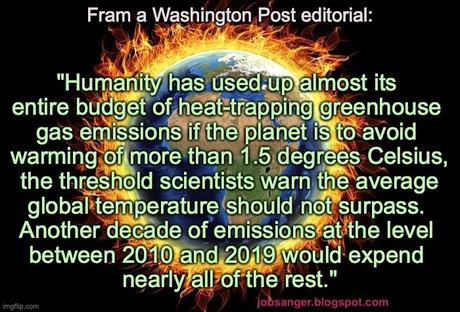 The following is from the editorial board of The Washington Post:
The following is from the editorial board of The Washington Post: Every half-decade or so, the United Nations’ Intergovernmental Panel on Climate Change releases an authoritative report on climate change, reflecting the consensus view among a vast number of experts and government officials. The latest installment, on the path humanity must take to avoid punishing climate consequences, came out on Monday. Another analysis filled with dire warnings, the latest report might seem depressing — or, depending on one’s point of view, encouraging.
The report found that humanity has used up almost its entire budget of heat-trapping greenhouse gas emissions if the planet is to avoid warming of more than 1.5 degrees Celsius, the threshold scientists warn the average global temperature should not surpass. Another decade of emissions at the level between 2010 and 2019 would expend nearly all of the rest. With the policies in place as of 2020, the world will warm 3.2 degrees Celsius. If nations meet the commitments they made under the landmark Paris agreement, they would nudge that down to 2.8 degrees. To get on track, global emissions must peak before 2025, then decline rapidly.
Sounds grim. The encouraging part is that progress is still possible — easier, in fact, than one would have expected even a decade ago. The cost of renewables such as wind and solar has plummeted. Battery technology has improved. Some 18 countries have cut their emissions for 10 years straight. The pathway is clearer now than it has ever been. Cheaper renewables need to be deployed quickly and at massive scale, with continued government aid. Building standards must cut energy waste from the built environment. Cities must require better public transportation and non-car infrastructure. Electric vehicles must become the norm and run on a cleaner energy grid. Better technology and less wasteful behavior could cut energy needs by half by 2050.
Further research will have to fill in a few gaps. Planes and ships might have to run on hydrogen. Industrial processes such as cement-making require improvements in chemistry. There might be some sectors that never decarbonize fully.
To offset these, countries will have to remove carbon dioxide directly from the air. The easiest way to do this is to stop cutting down trees and other plant life — and, indeed, to grow more. More outlandish ideas include “fertilizing” the ocean to induce CO2-gobbling plankton to proliferate, an idea that the report warns could have unintended effects on ocean ecosystems.
Indeed, governments will have to be mindful of myriad trade-offs. Using more land for solar farms and tree-growing means that it cannot be used to grow food for an expanding world population, so agricultural intensity will have to improve. Some people in legacy fossil fuel industries will lose jobs, even as employment expands in other sectors. Governments will have to subsidize research budgets and ensure that money flows into renewables. All told, the report concludes, the costs might mean that world gross domestic product is a few percentage points lower in 2050 — not accounting for the value of the environmental destruction avoided. But those benefits would far outweigh the costs.
The United States has rejoined the Paris agreement, and Congress is considering major climate legislation. As it has on the fight for democracy in Ukraine and a host of other global issues, it is time for the United States to lead again.

